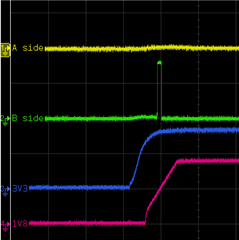Tool/software:
Hi team,
SN74LVC8T245 datasheet has power-up sequence requirement below.
> ”The recommendation is to first power-up the input supply rail to help avoid internal floating while the output supply rail ramps up. However, both power-supply rails can be ramped up simultaneously.”
Is there any specific timing recommendation or acceptable timing range to power up output supply rail on this?
The potential risk of violating the power-up sequence is just undefined output, correct?
I'd like to make sure it won't damage the device.
I found many thread related to this, but it's difficult to find all information my customer is asking for.
Best regards,
Kazuki Itoh


